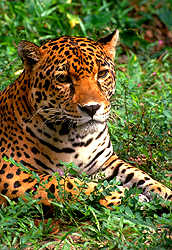
Lara Dale, Steve Gough,
Stacey Burke, and Julia Sherrill
Section Six - Journey of the Nightly Jaguar by Burton Albert pp.1-28

This simply worded yet illustrative picture book tells
about the legend of the jaguar, as according to Mayan myth. As the
sun goes down, the nightly jaguar comes alive. That is when he creeps
through the night, stalking, watching, and waiting. He roams through
the jungle, along crocodile infested river banks, and up into the canopies
of the tallest trees. And then, when the glory of the sun peaks it's
red rays over the horizon, the jaguar once again secludes himself...until
the setting of that same sun.
Discussion Director
The discussion directorís job is to develop questions for the group
members to discuss about this section of the book. The focus is on
important ideas and issues in this section and designing questions that
address them.
Your job is to ask the following types of questions:
1 Setting
2 MCEOG
Passage Picker
The Passage Picker's job is to select significant passages from the
selections being read; determine why those passages are important; call
other group member's attention to the passage; and lead a discussion about
the passage.
Steps:
1. Pick
out a passage you would like to share.
2. Write
down the page and paragraph number.
3. Write
down the first two words and the last two words of your passage.
4. Write
down the reason you chose the passage, and explain why! (Descriptive,
surprising, it contains figurative language, or it is important)
5. Ask
a question about your passage, and give an answer.
6. Write
down the Authorís Purpose: To Describe, To Entertain, To Inform,
or To Persuade
Your job is to choose:
1 passage containing figurative language
2 descriptive passages
1 informative passage
Word Wizard
The Word Wizard's job is to search the section being read for words
that are key to understanding what is happening in the story; note the
page and sentence where it can be found; check the dictionary meaning of
the word; lead a discussion about the meaning and intent of the word from
context and what the word contributes to the importance of the passage.
Steps:
1. Write down the word, the page and paragraph
number.
2. Copy the sentence from the book in which
the word appears.
3. Write down the part of speech the word
is in (noun, verb, adjective, or adverb) and what you think the word means.
4. Using the context clues from the sentence
and the dictionary definition, write in your own words the
definition of the word.
5. Tell how this word adds meaning to the
story.
6. Make your Word Wizard card. Be sure
to include in big print, your word and the page and paragraph
number. On the other
side of the card should be a picture, the word, and the definition of the
word.
Your words are:
ebony - p.7 par.1
windsongs - p.8 par.1
luring - p.10 par.1
cascades - p.11 par.1
Character Sketcher
The Character Sketcher's job is to develop a character map of major
characters in the section of text being read.
Steps:
1. Pick out a character that interests you. Choose three
words to describe this character. These should be implied character
traits; that is, they are not directly stated within the text.
2. For each trait, you will give proof (an example) from the
book (write down page and paragraph).
3. Write out the character's goal, problem, and solution (page
and paragraph).
4. Last, you will draw a picture of your character.
Your character for this job is the Jaguar
Activity Activator
Your job is to design a graphic organizer to go with the story.
Examples could include:
Story Map
Plot Chart
Character Map